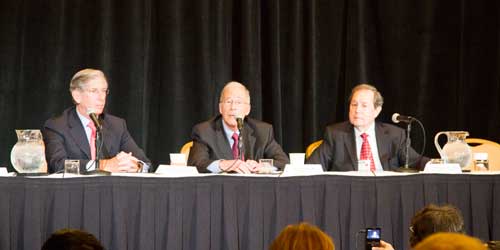American Psychiatric Association Releases Dsm-5

Drs. Lieberman, Kupfer and Regier announce the launch of the DSM-5
As the release of the American Psychiatric Association’s (APA) fifth edition of theDiagnostic and Statistical Manual (DSM-5)looms, more than 13,000 psychiatrists descended upon San Francisco, Calif. For the APA, the first order of business was to launch theDSM-5and answer the many questions about the revisions – and controversy – of this much-anticipated publication.
DSM-5’s New Organization
Among the many changes within theDSM-5’s pages, what theDSM-5Task Force is most excited about are the revisions with the organization of the manual. Not only are the more than 15 significant changes to disorders, but the authors reorganized theDSM-5to make it easier to use for clinicians.
“The process wasn’t so pretty,” said Jeffrey A. Lieberman, M.D., president-elect of the APA. “Regardless, we believe this represents the gold standard of psychiatric diagnosis based on the research available to date.”
The newest addition to the overall structure of the manual is the last section that includes key components to help translate this research into practical, daily use for clinicians, researchers and others. First, this section includes conditions that require further research before they’re considered to be a formal disorder. Some of these disorders, such as anxious depression and sensory processing disorder, lacked enough scientific evidence to consider it a “done deal” – coined by David Kupfer, M.D., chair of the DSM-5 Task Force.
Additionally, this section of theDSM-5includes a toolkit that helps mental health professionals learn about and apply these diagnoses in clinical settings. This toolkit also covers self-assessment tools and various resources that address cultural components as they relate to diagnosis and treatment options.
“The Glossary of Cultural Concepts of Distress in theDSM-5’s third section was an important piece to include,” said Dilip V. Jeste, M.D., president of the APA. “Mental illness is something that crosses cultural barriers, and we wanted clinicians some tools to address the culturally sensitive nature of some mental health issues.”
A Call for More Research
A topic that some of the media wanted to focus on during theDSM-5launch was the perceived difference of opinion between the National Institute of Mental Health Director Thomas Insel, M.D. and the APA’s revisions. (The NCRG covered this debate with aGambling Disorders 360°postlast week). When asked about it, theDSM-5Task Force and APA leadership discussed the need to have research bring forth biomarkers and so that the diagnostic criteria could be further refined and the mental health field could advance.
“While we don’t have the biomarkers that are on the verge of discovery in research, patients can’t keep waiting,” said Dr. Kupfer.
Make sure to follow the NCRG onTwitter,FacebookandStorifyfor the latest news from the APA annual meeting.
NCRG staffIn the NewsaddictionAmerican Psychiatric AssociationAPAdisordersgamblingmental healthpsychiatrypsychology

